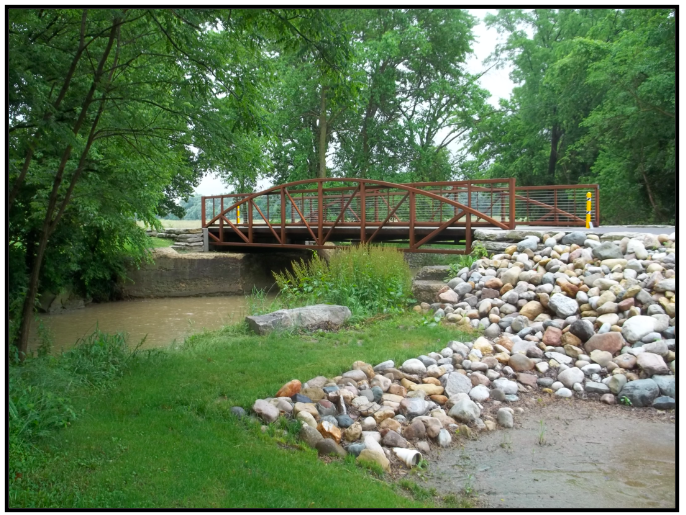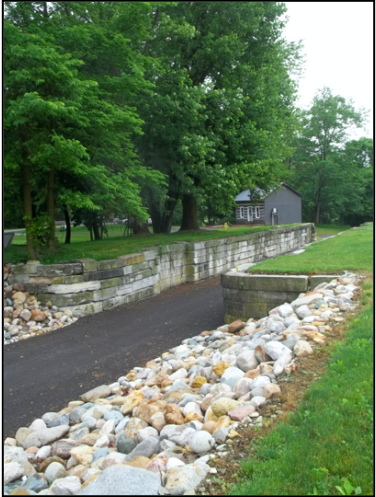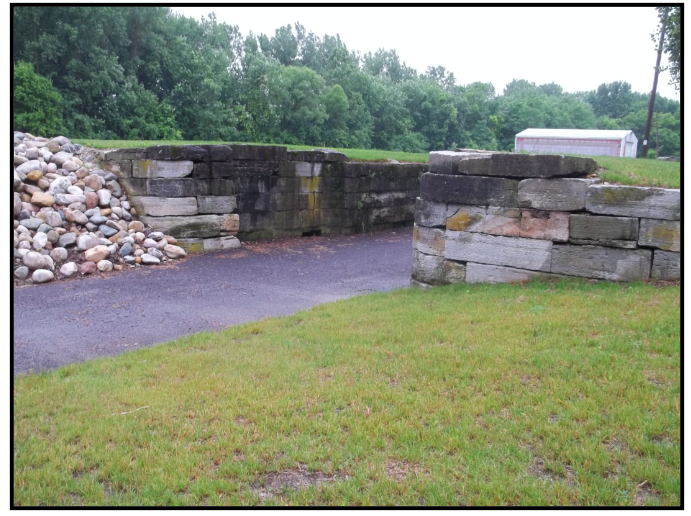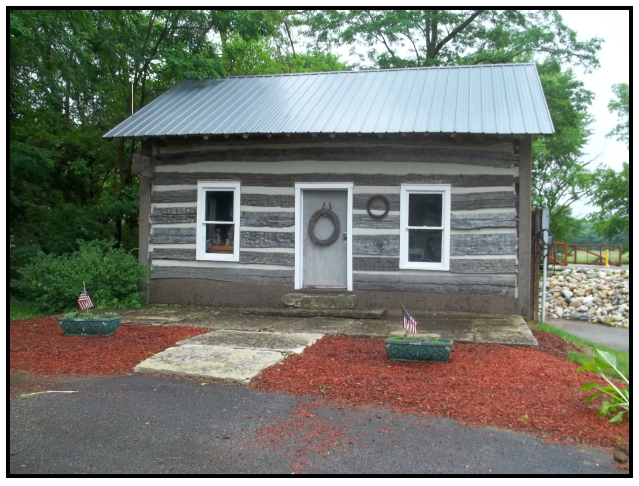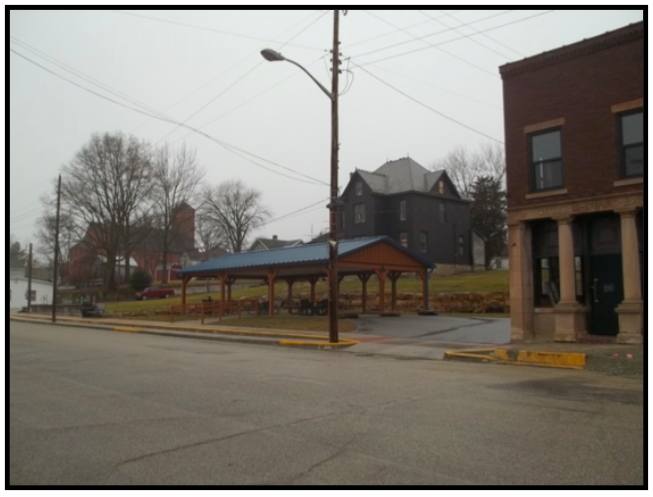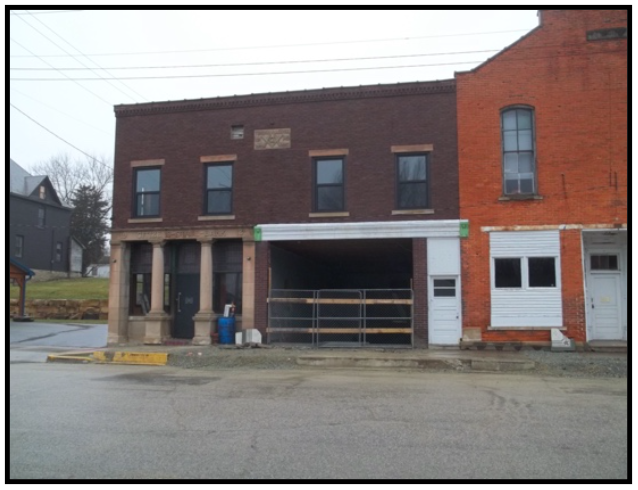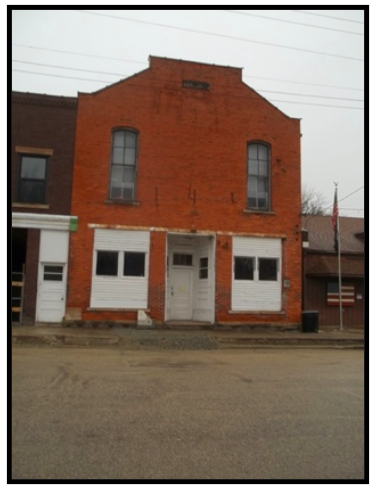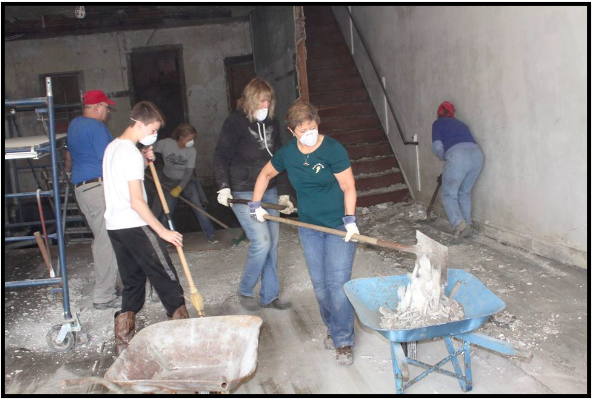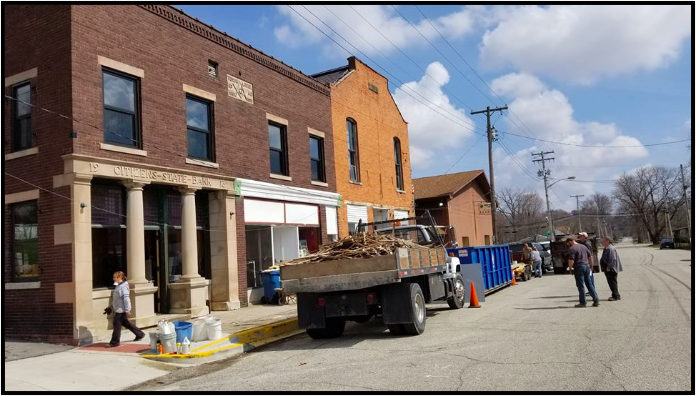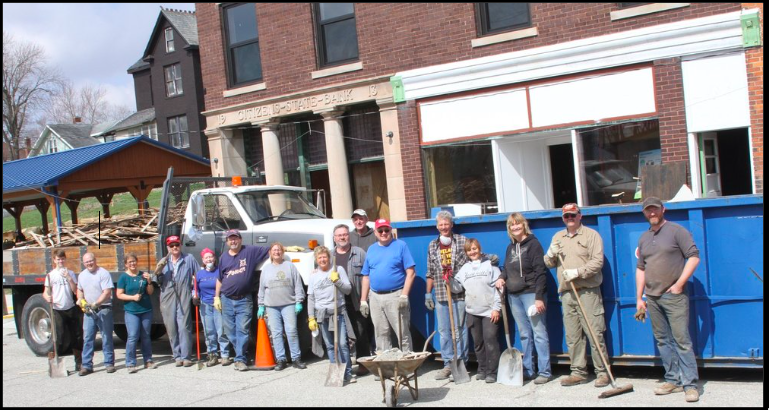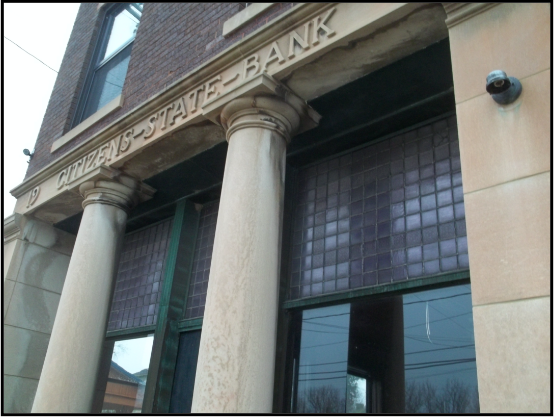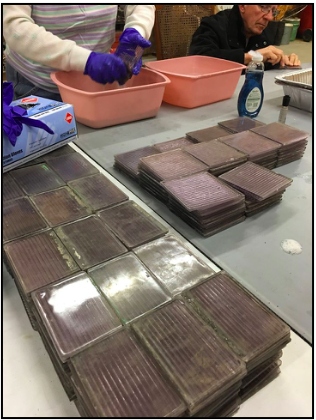
4th of July Canalabrations
By Carolyn Schmidt
Although the 4th of July had previously been celebrated, it was the War of 1812 with Britain that really rallied the citizens of the United States and strengthened this day of national unity. The people and sections, who disagreed with each other during most of the year, came together to celebrate this day.

During the war the United States had faced difficulties moving its troops to the Canadian border and south to New Orleans. It was thought that building canals could be very beneficial to our nation’s security.
Therefore, it was not a coincidence that officials decided to start construction of New York’s Erie Canal on July 4, 1817. It was a day for national jubilee as people were willing to work together to improve the nation.
July 4, 1817 Erie Canal
On July 1, 1817 DeWitt Clinton became governor of New York. As such he was in a position to carryout New York’s canal project. Three days later on July 4, 1817, a groundbreaking ceremony was held near Rome, New York, for the construction of the Erie Canal also known as “The Grand Western Canal” and “Clinton’s Ditch.” Citizens and those associated with the project gathered at sunrise at a place near the arsenal. Cannons boomed as Judge John Richardson drove his team of oxen pulling the plow that broke the ground for the Erie Canal. He had signed the first canal construction contract and thus earned the honor of making the first cut. Many men, who were eager to take part in the momentous occasion, had brought their shovels to the ceremony. They, along with various officials, began digging as the cannon boomed once more. They were addressed by Judge Joshua Hathaway, who said that the waterway “will unite [Lake] Erie with the Hudson, the west with the Atlantic, which will scatter plenty along its borders; carry refinement and civilization to the regions of the wilderness.’’
The canal planners signed about 50 contracts for work on the first phase. The men who received the contracts generally owned land in or along the canal’s path. They were farmers, carpenters, mechanics or businessmen.
Two rows of red wooden stakes set six feet apart were placed along the canal route for Richardson and his men to know where to clear the land. Between these rows the surveyors set two more rows of stakes forty feet apart that marked where the actual ditch would be dug. When finished the canal would be forty feet wide at the top and taper in a U-shape to 28 feet wide at the bottom. It would carry 4 feet of water.
The Erie Canal was 360 miles long and was completed on October 26, 1825. It was enlarged two times as traffic increased. “…it was considered the first and most successful of a group of canals that connected the Eastern seaboard cities across the western range of settlements along the Appalachian Mountains and on to the Great Lakes.” according to James R. Heintze in The Fourth of July Encyclopedia.
July 4, 1825 Chesapeake and Delaware Canal
The Chesapeake and Delaware Canal was first toasted at a dinner celebration held in the Easton Hotel, in Easton, Maryland as “a national work destined to produce incalculable benefits.” In attendance were the governor of Maryland, Samuel Stephen, Jr. and other dignitaries. It would be 14 miles long extending from the Delaware River to Chesapeake Bay.
July 4, 1825 Ohio and Erie Canal
Groundbreaking for the Ohio and Erie Canal, which was to extend 307 miles connecting Lake Erie to the Ohio River, took place at the Licking Summit near Newark, Ohio with 8000 spectators in attendance. Dinner was served to the invited guests and those who could afford to pay $1.50 per person while others ate the picnic lunches they brought with them. Speeches were delivered by DeWitt Clinton of New York, Governor Jeremiah Morrow of Ohio, and Thomas Ewing of Ohio, who was the orator of the day. Tears were said to have flown down the cheeks of the attendees as they realized the canal would extend the markets for their produce and bring them more income.
July 4, 1826 John Adams and Thomas Jefferson died
Fifty years after the Declaration of Independence was signed, Americans looked back and observed the progress that had been made. According to Perkins in Historical Sketches of the United States from the Peace of 1815 to 1830, “Their numbers had quadrupled, progressing from two and a half million to ten million. Their wealth, strength and means of defense had increased more than ten fold. From a small, scattered population, bordering on the western shores of the Atlantic, they had extended beyond the banks of the Mississippi to the Rocky Mountains. The very singular occurrence on this day was the deaths of [John] Adams and [Thomas] Jefferson, two of the distinguished signers of the Declaration of Independence, who lived to see its light, gave it a peculiar interest.”
John Adams was 90 years old. He died a 6 p.m. on July 4, 1826 of debility of age.
Thomas Jefferson was 83 years old. He died at 1 p.m. on July 4, 1826 at Monticello after a slow illness that caused him to waste away.
July 4, 1827 Ohio and Erie Canal
Two years after the ground was broken for the Ohio and Erie Canal, it was opened for navigation from Cleveland to Akron, Ohio on the 4th of July.
July 4, 1828 Chesapeake and Ohio Canal
Ground was broken by U.S. President, John Quincy Adams, for the Chesapeake and Ohio Canal. Early that morning the directors of the C&O Canal Company met members of Congress, military officers, secretaries of executive departments and foreign dignitaries at Tilly’s Hotel in Georgetown [District of Columbia]. They proceeded to march to High Street wharf accompanied by music from the U.S. Marine band. Some of the officials boarded the steam boat ‘Suprize’ that followed behind a barge carrying the band, which was playing lively and plaintive songs, and proceeded up the Potomac River to one or two hundred yards East of the line of the Canal, a spot that had been marked by Judge Wright, the engineer of the canal company. Speeches were given before an audience of thousands of people as well as several military companies. Then President Adams said, “We hope and believe that its (the canal’s) practical advantages will be extended to every individual in our Union.” He then tried to dig his shovel into the ground but hit a tree root. After several attempts, he succeeded followed by “a loud and unanimous cheering.” Later that day the printers of Washington City held a celebration which toasted “The Earth this day dug at the Canal Celebration. We look anxiously for the day when the united water of three great streams shall rush through the spot it so lately occupied.”
When completed the C&O Canal was to have stretched 360 miles from Georgetown to near Pittsburg, Pennsylvania. However, it was not completed as planned with the section to the Ohio River at Pittsburgh never being built.
The C&O Canal ended up being 184.5 miles in length and ran along the Potomac River from Washington, D. C., to Cumberland, Maryland. It mainly carried coal from the Allegheny Mountains.
Construction began in 1828 and ended in 1850 when the 50-mile stretch to Cumberland opened. The elevation of the canal rose and fell over 605 feet. It required the construction of 74 locks, 11 aqueducts to cross major streams, more than 240 culverts to cross small streams, and a 3,118 foot long tunnel known as the Paw Paw Tunnel.
The Chesapeake and Ohio Canal National Historical Park now maintains a trail that follows the old towpath.
July 4, 1829 Chesapeake and Delaware Canal
Another or second 4th of July celebration was held when the Chesapeake and Delaware Canal was completed. At that time the embankments at the summit were opened and water let in connecting the Delaware River to Chesapeake Bay.
July 4, 1843 Wabash & Erie Canal
According to Paul Fatout in his book Indiana Canals, “The conventional time for ground-breaking ceremony was Fourth of July, but the federal deadline of March 2 (1832) for beginning the Wabash canal ruled out Independence Day. Canal commissioners chose the best next date, Washington’s Birthday, and Fort Wayne people convened in a mass meeting to make preparations for the event.”
It was not until 11 years later when the Wabash and Erie Canal was completed from Lafayette, Indiana to Toledo, Ohio that the line boat Albert S. White completed the first trip on May 8, 1843. On the Fourth of July that year a grand celebration marking the opening of the 175 miles of interstate waterway was held in Fort Wayne. “A sunrise salute of twenty-six guns initiated an artillery barrage that boomed all morning. Double tiers of boats decorated with flags lined the wharf the length of the town, from Lafayette Street to Harrison, and hospitable residents opened their doors to all comers, dispensing good cheer by collation, by decanter, and jug. The Toledo Guards came to town, a band from Defiance, Governor Ethan Allen Brown of Ohio, farmers and villagers from miles around. Prominent gentlemen, unable to attend sent regrets: Martin Van Buren, Winfield Scott, Henry Clay, Daniel Webster. General Lewis Cass, orator of the day, sailed in from Toledo on the packet Ohio, reception committee and crowd at dockside to welcome the distinguished guest with proper acclaim.” The celebration concluded with an ox roast at the Swinney homestead on the banks of the canal near the St. Marys aqueduct.
Both United States Senators Albert S. White and Edward A. Hannegan and several members of Congress were present, according to the History of Allen County.
July 4, 1853 Wabash & Erie Canal
Another celebration was held near the St. Joe Feeder Dam of the Wabash & Erie Canal in Fort Wayne, Indiana. Guests were transported to the picnic grounds via canal boats. The Fort Wayne Times and People’s Press carried the following article about the event on July 6, 1853.
“The 4th. — Monday was the anniversary of the ever glorious, ever to be remembered Fourth of July. — There was no regular celebration of the day, after the old-fashioned manner, by our citizens; but that did not suppress the spontaneous outbreak of swelling joyousness, and volunteer patriotism from the inmost hearts of all classes. — Soon after midnight a celebration of the approaching day was commenced … without preconcert, by the firing of guns, the explosion of crackers by platoons, the lighting of bonfires, and various other exhibitions of exuberant and overflowing patriotism. At sun-rise all the bells in the city rang out a merry peal, and all were animated with hilarity and joy.
“The leading feature of the day was to be the “Pic-Nic,” near the feeder dam, five miles north east of the city, that had been arranged by some of our public spirited young ladies and gentlemen. At an early hour omnibuses and other carriages were rolling in every direction, gathering up the precious freight of beauty and fashion, and conveying it to the Packets that had been chartered for the occasion. At 9 o’clock all was ready and the boats moved gaily from the packet-landing, to the enlivening strains of the fine Fort Wayne Band, under the fluttering of flags, and literally piled, packed, jammed and crowded, with ‘as gallant lads and bonnie lasses’ as any town in the great Hoosier nation can turn out. The passage up the Feeder was highly pleasant and picturesque. Upon arriving at ‘the Dam,’ a procession was formed, and marched about eighty rods into a dense forest, where the exercises of the day were to take place. — The spot was well chosen. It was on the land belonging, we understand, to the estate of the late John B. Bequette, between the Feeder and the [St. Joseph] River, and a perfect sylvan retreat. By the provident forethought of the Committee of Arrangements, it had been cleared of the undergrowth, and rough seats and tables, appropriate to the place and the occasion, erected. The tall old trees stood around in their primeval grandeur, majestic and stately ….
“The ceremonies were opened by a solemn and impressive prayer by the Rev. Mr. Edwards, of the first Presbyterian Church; the Declaration of Independence was read by H. N. McCormick; and a beautiful and appropriate oration was pronounced by Isaac Jenkinson, Esq.; the whole interspersed with thrilling and patriotic airs by the band.
“The company then dispersed for a short recess….[while] numerous mysterious looking baskets, buckets, boxes, and packages [were opened] to the light of day. Anon the bugles sounded the appointed signal, the company re-assembled…. The long tables…were heaped high with the materials for a rich and profuse collation…. It was the most substantial and abundant, as was fully and speedily demonstrated by actual experiment of its quality and quantity.
“After the tables were cleared, the following toasts were read by Charles Case, Esq., and drunk (in floods of lemonade) amid the enthusiastic cheers of the company:” [Thirteen regular toasts and 22 volunteers’ toasts were given that are not listed here.]
“Thanks, many thanks are due to the young ladies and gentlemen who projected and so nobly carried out this pleasant excursion. They conferred a benefit upon all who partook of their hospitality, and by their admirable arrangement and management did themselves very god credit. No more appropriate or agreeable method of celebrating the ‘glorious 4th’ could be devised; nor could it have been in better style conducted.”
Sources:
Aller, Susan Bivin. What Difference Could a Waterway Make? Minneapolis, Minnesota: Lerner Publications Co., 2011.
Brockway, Chance. Images of America: Newark. Great Britain: Arcadia Publishing, 2004.
Fatout, Paul. Indiana Canals. West Lafayette, Indiana: Purdue University Press. 1972.
Heintze, James R., The Fourth of July Encyclopedia. Jefferson, North Carolina: McFarlend & Company, 2015.
History of Allen County, Indiana with Illustrations and Biographical Sketches. Chicago, Illinois: Kingman Brothers, 1880.
Johnson, Crisfield. History of Cuyahoga County, Ohio. Cleveland, Ohio: D. W. Ensign and Co., 1879.
Perkins, Samuel Esquire. Historical Sketches of the United States from the Peace of 1815 to 1830. New York, New York: S. Converse Publisher, 1830.
Sheriff, Carol. The Artificial River: The Erie Canal and the Paradox of Progress, 1817-1862., New York, New York: Hill & Wang, 1996.
The American Almanac and Repository of Useful Knowledge for the Year 1830. Boston, Massachusetts: Charles Bowen, 1830.
“The 4th.” Fort Wayne Times & People’s Press. 6 July 1853.
Thomas, Alexander R. and Polly J. Smith. Upstate Down: Thinking About New York and Its Discontents. Lanham, Maryland: University Press of America, 2009.
Once a Canal Town, Lagro is Being Refurbished
By Sue Simerman and Lavonne Sparling
Lagro, Indiana, the town that had four locks on the Wabash & Erie Canal has been showing several years of activity. Many volunteer hours are evident and much more will happen in the next few years.

The Canal Society of Indiana has been watching the Kerr Lock on the east edge of this town for many years. The spark of a group called Wabash River Trail Inc. wants to complete a trail from Peru to Huntingon. In recent years they have put in a paved trail along the Wabash River at Lagro, a foot bridge over Lagro Creek, a pavilion beside the 1913 bank building and public restrooms. Their website is wabashrivertrail.org.
Lagro had been on the decline and many buildings that were busy during the canal era had been torn down. Three run down buildings in its downtown came up for auction in 2017 and very likely would have been torn down by the county. If this had happened then the American Legion building would have been the sole survivor.
Beth Gillespie bought the buildings in the hope of saving them. She got a group of volunteers together. They have gotten permits and received donated materials and monetary donations. They have put on fundraisers and created a Facebook page as well as putting in many volunteer hours of physical labor. There is still much that needs to be done.
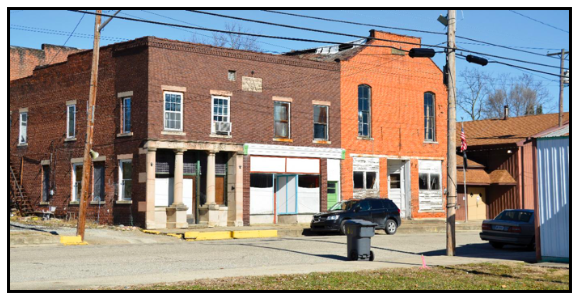
Look at their website to watch a video of what might be done with the buildings. The Ian Stallings Design firm of San Francisco is helping with these creative ideas. Stallings has connections to the area and has purchased a home close by to return to its original state.
With the help of Tom Castaldi, CSI director, I, Sue Simerman, made several contacts with the Lagro Canal Foundation. Board member Lavonne Sparling was kind enough to write up the story of this group. She did such an excellent job that I am letting her tell their story as follows:
Just a few short years ago, Lagro was in a ‘tougher’ spot: the only café in town closed; the bar and grill burned to extinction; population was dwindling; and there was no evidence that this was going to change anytime soon.
Fast forward to today. A bike trail is coming through Lagro and the Wabash River Trail organization constructed public restrooms and a pavilion for the community. They enhanced an old boat launch on the river next to the 524 river bridge so groups of friends and families floating the river are now a frequent sight in summer months. They paved Basin Street, the parking lot at the ball diamond and around the Community Center. An old bridge foundation down at the east end of town now has a bridge over Lagro Creek and the Kerr Lock has been given a facelift.
The Lagro Parks Board raised funds for new playground equipment at the Community Center and replaced the dilapidated fence around the area with a bright new white one. Lagro Good Ole Days Board works hard to raise funds to provide the community with many family friendly events during the town festival every June.
The old Williams home is located just north of the infamous ‘Stone Wall’. This historic home was for many years owned by Harry and Ardelia Williams who were the grandparents of actress Shelly Long. The home is now owned by Ian Stallings of Ian Stallings Design http://www.ianstallings.com, an architectural design firm based in San Francisco with national and international projects in its portfolio. Mr. Stallings has begun renovations on the home in hopes of returning it to its original state. The home will provide lodging and studio space for the Wabash International Artist Residency (WIAR). Through WIAR https://www.thewiar.or, Stallings plans to “ignite culture and a love of art throughout the Northern Wabash River Valley.”
An old ramshackle canal house on Washington Street, was purchased and renovated to serve as an airbnb by Justin Gillespie and Beverly & Trent VanHaafton. More recently, they have purchased and are making plans for the two homes on adjacent lots. Barb Drook and Tim Moroney purchased and are renovating the Stephenson home that was built around 1950. The Stephenson’s owned and operated the local grocery store for many years.
On the southwest corner of Davis and Main streets sits the old Fire Station. In addition to being the town’s fire station, the upper floor was residence for the community center, township trustee, and Lions Club. A mason has been busy with the exterior brick and the owners, John and Joanie Potter from Nevada, are renovating on the interior. They too would like to establish a business in the building.
In spring of 2017, historic buildings located “downtown” on Washington Street were on the Wabash County Commissioners’ sell list. If not purchased, the buildings were destined for demolition. Beth Gillespie couldn’t let this happen. Her childhood home was a dairy farm just east of town. She grew up hearing stories centered on the rich history of Lagro. The town, nestled on the Wabash River, was a bustling commercial center during the canal days. A series of four locks assisted the canal boats in navigating the changing water levels. Today the site of the Kerr Lock, with its easily viewed limestone blocks, attracts many visitors who are interested in canal history.
Photos by Sue Simerman
The Tuscan Lodge, built in 1913, housed the Lagro Bank and the Lagro Hardware in its two storefronts. Local residents of several generations relate stories of fond memories from their time spent in this building. The wood stove in the hardware was used as a gathering place. Later the soda fountain of Marsh Garber’s variety store provided a local social center. Upstairs was the Masonic Lodge, home of the Masons.
St. Patrick’s Church is in the background on the far left with the now deark brown Williams House purchased by Ian Stallings Design in the center background, the pavilion built by Wabash River Trails in the center foreground and the bank building/Tuscan Lodge on the right of the first picture. Gillespie purchased the following three buildings to be restored as a café, restaurant or shops with apartments above them. The Tuscan Lodge was above the Lagro Bank and Lagro Hardware. The Improved Order of Red Men was in the building on the right.
Photos by Sue Simerman
The adjoining building to the east was built for The Improved Order of Red Men. The IORM is America’s oldest fraternal organization and is devoted to inspiring a greater love of the United States of America and the principles of American Liberty. The fraternity traces its origins back to 1765 and is descended from the Sons of Liberty.
Attached to the north, four brick walls (no roof) enclose a large area that once served as a warehouse.
Beth purchased these buildings from the county at the commissioners’ auction. Her dream is to renovate the buildings so that they can again contribute to the economic development of the area. She contacted friends and family to find support for her quest. The result was the formation of the Lagro Canal Foundation (LCF) https://www.lagrocanalfoundation.com in the spring of 2017. The LCF is a 501(c)(3) non-profit with a mission “to promote the revitalization of the community of Lagro, Indiana through education, historic preservation, beautification of public spaces, and marketing of Lagro’s natural amenities”.
The Lagro Canal Foundation’s first project is to renovate the historic downtown buildings. The main floors will serve as commercial space with the second floor providing living units. The large open area (former warehouse) behind the Tuscan Lodge building will be an open-air event space.
The glass tiles behind the bank pillars needed to be cleaned in place, but were not removed. They were made by the Luxfer Glass Co. of Chicago and based on an 1885 patent. They redirected light toward the ceiling and to the back of the building. Placed as transom lights above store front windows they were very popular and can be seen on The Landing at Fort Wayne and in a building in Delphi, Indiana. The glass prism tiles being individually cleaned are going into the hardware building beside the bank building.
The buildings are eligible for the National Historic Register and the LCF is in the process of obtaining the official designation. Community volunteers have spent hundreds of hours removing trash and rotted debris from and around the buildings. Donors and grants have made possible work on the exterior of the Tuscan Lodge. Windows have been restored or replaced with historically accurate models. The masonry has been cleaned and repaired. The front entry doors have been restored. Work on the hardware storefront, including the prism glass tiles in the transom, will soon be complete.
The ultimate goal for the buildings is to create a regional destination for families. Encouraging entertainment, dining and new business development will lead the way. Saving these buildings is not just about salvaging the physical structures in this once glorious little agricultural merchant village, it is about investing in the economic sustainability of a community and bringing it back to the vibrant place it was not so long ago.
As a result of all this activity, there has been a noticeable transformation throughout the community. Come to Lagro. Stay at a local airbnb: The Carriage House, Love’s Hideaway, or coming soon, the Riparian. Enjoy the nearby hiking trails at Salamonie State Forest and at several Acres, Inc. locations. Take a walk or ride on the first short segment of the bike trail, view the Kerr Lock, visit St. Patrick Catholic Church, and in the summer, stop at the Interurban Ice Cream shop for ice cream or a River Dog. Check back often to watch the progress.
For more detailed information on Lagro and the Wabash and Erie Canal I, Sue, suggest reading WABASH AND ERIE CANAL NOTEBOOK III by Thomas E. Castaldi. It is on the CSI website at https://www.indcanal.org or might be found at your local library. It covers Indiana’s Wabash and Miami counties.
If you wish to make a donation please use the following address:
Lagro Canal foundation
P O Box 3
Lagro, Indiana 46941
texting to give (260) 217-0144
Drowned in Indiana’s Canals
By Carolyn I. Schmidt
During Indiana’s canal era and afterwards when portions of Indiana’s canals remained watered, canals created a dangerous situation for those traveling on them or living near them. Here is a compilation of articles that were published in newspapers, county histories and Senate or House journals about those who drowned or nearly drowned. Since they were found on microfilm at the Allen County Fort Wayne Public Library, some of them were difficult to read so an underline or dots have been used to show unreadable parts. I have tried to clarify some things by putting brackets [ ] around them.
Fort Wayne Sentinel
March 15, 1845
DESTRUCTION OF THE DAM AT NORTHPORT—Three persons drowned. — On Saturday last the feeder dam across the Middle Fork of Elkhart [river], in Noble county, was undermined and partially carried away by the freshet. James Campbell and his adopted son, and William Abbott, who had been engaged in building a bridge, were standing on the bank close by the dam at the time and the bank caving in with them, they were swept into the flood and drowned. The body of Abbott was recovered on Wednesday, but neither of the others has yet been found.
This dam [near Rome City, Indiana] was commenced by the State to feed the Erie and Michigan canal. Since the abandonment of their work, it was finished on account of the valuable water power it created. The damage is estimated at $6,000.
Logansport Telegraph
June 16, 1844
Distressing Occurrence. Packet Boat Kentucky Lost and Three Persons Drowned. —We stop the Press to announce the painful intelligence of the loss of the Packet Boat Kentucky, commanded by Capt. Hammond, and the death of our esteemed townsman, Mr. Thomas Emerson, and also Mr. Griffin of Fort Wayne, and Mr. Burns from English’s quarry, who were all drowned.
Captain Hammond reported in the same paper: Packet Boat “Kentucky” lost and three persons drowned, three and a half miles below this place [Logansport] at 8 o’clock last evening on my passage from Lafayette. The towing path gave way as I was passing the place and I escaped it, but sixty yards beyond, around a short bend there was another. There I was between two breaks at one time only 60 yards apart and both gave way at once. I got the stern line on the firm bank and a line on the tow path but both lines parted in an instant. Away went the boat through the break into the woods striking a large tree breaking the boat in two, turning her hull upwards and breaking the boat all to pieces.
At the time of the wreck, Mr. F. Brown, proprietor of Brown’s Hotel of Lafayette was on board. He, along with three or four of the boat’s crew were saved almost miraculously. When the boat left the bed of the canal and was carried to the river by a torrent of water, it broke in two and the part of the boat that Mr. Brown was on turned completely over, taking him under with it. In turning he caught the railing and by that means he was saved.
He together with the crew, remained on a log all night in the most perilous situation, the water around them was some eight or ten feet deep, the place was such that no assistance could be rendered them until morning. Hundreds of our citizens have been on the ground, but as yet, none of the bodies have been found.
Delphi Oracle
June 22, 1844
Melancholy Accident — As the packet boat “Kentucky” was on her upward trip, a small breach occurred in the bank of the [W&E] canal, caused from the heavy rains for several days previous and then failing, which the driver supposing he could pass, put the horses to their speed which caused an increased motion of the water, and at the moment the boat came opposite the break, the bank gave way for some distance, sufferers became frightened and jumped off on the bank which also gave way, burying them beneath it. The boat, with the captain and crew and several passengers yet on board, was driven among the stumps and trees toward the river, until broken in pieces those on board saving themselves by clinging to the trees until assistance could be rendered.
The same paper reported several days later: Report of Carroll County’s Coroner, T. C. Hughes:
An inquest was held on the 21st inst., on the body of R. J. Griffin, taken from the Wabash river afloat at Delphi, Carroll County, Ind., supposed to have been drowned. Deceased was between the age of 20 and 30 years; had on a beaver cloth over-coat, black velvet buttons, and silk braid loops; blue-black dress-coat, red striped vest, black cassimere (sic) pantaloons all much torn. The following articles were found on his person; one horn handled pen knife, one pitch pipe, five small keys, half an ivory rule, $16 in money, one black morocco pocket book, and one map of the western States. Said deceased resided in Fort Wayne, Ind., and was lost from the canal packet boat Kentucky, near Logansport on the 15th inst.
Fort Wayne Times & Peoples Press
October 19, 1848
DISTRESSING ACCIDENT — On Sunday morning, last, an interesting little daughter of Mr. Wm. Isa of this city, while her parents were absent at church, was permitted to go to the [W&E]Canal, and after getting on board the boat Uncle Sam, in an unguarded moment missed her footing and fell into the Canal. — The alarm was given by some persons on the boat, and a number of citizens soon collected and were actively engaged in searching for the body. After raking the Basin for some half an hour, the body was recovered. Physicians were immediately called, and every effort was made to resuscitate life, but all proved vain; the vital spark had fled forever.
Miami County Sentinel
April 19, 1849
A NOBEL ACT. — A little son of E. C. White, grocer, fell into the [W&E] Canal near Columbia street on Wednesday afternoon, and was rescued from an untimely death through the noble daring of a young boatman named JOHN TREADWELL.
This young man was standing upon the bridge, and seeing the boy’s hand sticking out of the water, he immediately plunged in (though he could not swim a stroke,) and succeeded in pulling him to the shore. Animation was entirely suspended, but by the application of restoratives he was again brought to life.
The boy was not seen when he fell in, and but for the timely interference of young Treadwell, he undoubtedly would have perished.
It does our heart good to chronicle such deeds of noble daring as the above, as it proves conclusively that there are still brave hearts beating in the world that are ever open to the promptings of humanity. Such men as Mr. Treadwell, deserve the admiration of the whole country. He is one of Nature’s noblemen. Pass him round! —Lafayette Courier (Reprinted in the MCS)
_
Documents of the General Assembly of the State of Indiana at the 30th Session, Commencing December 1, 1845. Indianapolis, IN: J. P. Chapman, state Printer, 1846. In this book is the “Report of the Superintendent of the Wabash and Erie Canal to the General Assembly, December 1, 1845.” Indianapolis:, IN: J. P. Chapman, State Printed, 1845, which says:
The Northport feeder dam in Noble county [Sylvan Lake near Rome City], was completed during last winter, by the contractors, Messrs. [Francis] Comparet and [Francis] Avaline, and the Legislature it will be recollected, appropriated $1,000 in addition for the purchase of lands for mill sites of Francis Comparet; but before the act could be carried into effect, Comparet died, and it still remains in the same situation. At the breaking up of the Spring, however, the tumble that was placed in the dam, by the action of the frost and water, became undermined and washed out, drowning three persons who were the idle spectators of the scene.
Such a work should not be left as that was, without some provision for some person to superintend it, and prevent such an occurrence. But there was no provision in the law to authorize the employing of any person to take charge of it; hence the disastrous result that attended it, together with the melancholy reflection that three unsuspecting and unlooked for lives were unfortunately lost.
Fort Wayne Times & Press
August 15, 1846
Drowned. — On Tuesday evening last, Stephen Caspar, one of the waiters on board the packet boat Albion, was drowned in the canal near Fairport [in east Allen county, Indiana]. It appeared in evidence before the coroner, that he was sleeping on the deck, and on being suddenly aroused, got up partially awake and walked overboard. The boat was immediately stopped, but the unfortunate man was drowned before assistance could be rendered. His body was soon after recovered; but the vital spark had fled. — Sentinel
Miami County Sentinel
April 17, 1851
MAN DROWNED — We understand that an individual named Nelson was drowned in the canal in the vicinity of Roanoke, ten________(unreadable)
Miami County Sentinel
August 14, 1851
DROWNED. — About 3 o’clock yesterday afternoon, a man aged about Twenty-eight years, named Elijah Koons, and two valuable horses belonging to the Livery Stable of Clinton & Lyman Taylor. It appears Koons at the time was taking the horses and buggy to the Wabash to wash them, while near the pivot-canal bridge [in Peru, Indiana] he put the horses into a run, and they ran heading into the river so far that to recover them was impossible.—The buggy sank, pulling with it the horses and driver. The horses and buggy were soon after discovered about half a mile down the river. The buggy and harness were recovered, but the horses were drowned, and the dead body of Koons was lost in the stream above and has not been found. This makes the fourth horse the Messrs. Taylors have lost by drowning within the last two months. Lafayette Daily Journal (Reprinted in MCS)
Fort Wayne Times & Peoples Press
May 8, 1851
Man Drowned.
We understand that an individual named Nelson was drowned in the Canal in the vicinity of Roanoke, ten miles east of this place, one day last week. He was intoxicated, or in plain words drunk at the time. Indiana Herald
Fort Wayne Times & Peoples Press
August 7, 1851
From the Cleveland Plaindealer,
Another Carriage off the Pier: A Woman and two Children Drowned — It is not long since we chronicled the fact of a Cab backing into the [Ohio & Erie] Canal [at Cleveland], and drowning a woman and child. This morning about 3 o’clock, the horses to the Omnibus of the Farmers’ Hotel walked off the Pier into the River, drowning a woman and her two children. The circumstances are briefly as follows: An Irishman, his wife and two children, one a little boy of about six years, the other, a little girl a nursing babe, took passage on the Propeller General Taylor, at Milwaukee for this place.
There came in company an Irish acquaintance living in this city. While the boat was at Maiden, stopping to wood on her way down, the first named Irishman got into some difficulty with another passenger, and when the mate was giving orders, winding, on leaving the dock there was much noise among the belligerents. In endeavoring to still them he had a clinch, and finally caught a hand spike and knocked said Irishman senseless by a blow across his head, breaking his nose and injuring his skull so that he has not spoken since. On landing here about 3 o’clock this morning, Atkinson, of the firm of Atkinson & Jepp, Proprietors of the Farmers’ Hotel, had his Omnibus on the Pier between the Depot and Rhodes’ new Warehouse. He had got the woman and her two children in the carriage, and went back to the boat, which was some twenty rods down the Pier, after the baggage; leaving the horses unattended. He met the first mate and the Irish friend leading the one who had been struck, and who was still senseless and quite helpless, towards the carriage. It is supposed he was placed inside with his family, as he was too feeble to support himself outside. When Atkinson returned with the luggage, his horses were gone. There was no one up at that hour who saw them start, and after looking around awhile concluded they had gone to their stable. He ran home, but not finding them went back to the Pier and saw the man who was hurt (Bray was his name) on the water. The cry was raised that a man was drowning. A sailor, on the opposite side jumped out of his berth and into a boat, rowed to the man, and found he was standing on the top of the carriage in which was his wife and two children, drowned! He could not articulate a word, and how he got outside the carriage is a mystery. The dead bodies of the mother and children were taken out of the Omnibus — the horses and fore wheels had got separated, and were found some distance below — the horses drowned. A Coroner’s inquest was held and a verdict rendered according to the above facts. The injured man, and sole survivor of the family, now lies senseless at the Farmers’ Hotel, and is not expected to recover.
Fort Wayne Times & People’s Press
March 22, 1854
An Infant Found. — We are advised of the finding yesterday of the lifeless body of a male child in the canal at the first lock [Taylor’s/Moot’s] east of the city. The supposition is that it had been thrown into the canal about town and the current had floated it to the lock, where it remained until the water was let off, when it passed through the paddle gate and was left on the bottom below when the water receded.
Its size indicated that it was born alive and at the natural period. A linen cloth had enclosed it, but had been partially removed, so that it hung about the neck. Decay had not yet commenced, from which our informant thinks it but recently since the inhuman parent disposed of it. In all probability the guilty agents will never be known to the world, but around their walks in life will hang dark forebodings of that hour when the Supreme Judge shall pass on the infanticide.
It is doubtlessly the fruits of unlawful commerce, between persons, whom to avoid the shame of the world had rather wear the “scarlet letters” of murderers. For shame!
The History of Wabash County, Indiana
June 8, 1854
On Wednesday, June 8, 1854, at La Gro, a man named William Walker, addicted to intemperate habits, at one of the numerous drinking places in town, imbibed quite freely of intoxicating beverages, and about 10 or 11 o’clock at night, having in the meantime had his bottle filled, put it into his pocket and started for home. His route lay across the [W&E] canal, and it necessary for him to pass over it at the lock in order to reach his domicile. After leaving the doggery, he was not seen again alive. The next day he was reported missing, and in the afternoon suspicion as to his safety being aroused, the short level of the canal was drawn off, and a search made for the missing man. Soon after, his body was discovered below the lock, and drawn ashore with a boat hook. The probabilities were that in attempting to cross over on the lock, he had lost his balance and fallen in, but was so much under the influence of liquor that he was unable to extricate himself and was drowned. When the body was brought on shore, his wife stood by in an agony of grief, and received his lifeless remains. His age was apparently about thirty-five years. The Coroner, upon investigation, found the facts substantially as given above. The deceased had a bottle of whisky in his pocket. That told the story.
Evansville Journal
May 8, 1855
Coroner’s Inquest. — A Coroner’s inquest was held on the 14th of April, 1855, in Pike county, Ind., over the dead body of a man found in the [W&E] Canal the evening previous, when the jury reported the following verdict, to-wit, that they believe the deceased came to his death by voluntarily going late to the Canal and drowning, and that from papers found among his effects, they suppose his name to be Henry Bash, a Dutchman, a peddler, about 40 years of age, dark complexioned, about five feet eight inches high. Deceased had on cotton clothing of a mixed color.
There were found on his effects the following, to wit
In Bank Notes on broken banks………………….$ 54.00
In Specie………………………………………….$ .24
Certificate of deposit in Crescent City Bank……..$350.00
In merchandise, jewelry, notions, etc…………….$ 64.14
E.P. Boone, J. P., Pike co. my8
The History of Wabash County, Indiana
December 1855
In December, 1855, James Highland was found in the [W&E] canal about four miles west of Wabash, near Fisher’s stone quarry, drowned. He was about twenty four years old.
Fort Wayne Weekly Times
December 6, 1855
DROWNED. — James Bird was drowned on Monday night, in Taylor’s Lock, one mile east of Fort Wayne. He was crossing the lock, we are informed, on a plank, carrying some kegs in his arms — fell in and was drowned
Evansville Journal
December 19, 1857
MYSTERIOUS DEATH. — On Sunday night last, a young man, a German Jew, named Abraham Meyer aged about 27 years, who had been for some days quite sick of a fever, left the house of a brother with whom he was staying and wandered out on the street. Not coming back as he was expected, search was made for him during the night but he was not found until Monday morning when he was discovered lying under the Sycamore street bridge in the canal, his head upon the bank out of water and his body in the water. He had evidently walked into the canal and perished in his effort to get out. It is supposed he was delirious with fever.
Evansville Journal
June 7, 1858
Yesterday a boy, whose name we have not learned, accidentally fell into the canal. Mr. Matthew McInnerny promptly jumped into the water and rescued him. A minister whose church on Sabbath evenings is crowded by boys and girls who while services are progressing do considerable sparking, did on this same evening improve the incident to his purpose of impressing on the minds of the juvenile lovers that life is uncertain, and death by accidental drowning without previous preparation is followed by a precipitation into the boiling cauldron which Old Nick incontinently keeps a sizzling in the lower regions for the unconverted souls of drowned boys.
The History of Wabash County, Indiana
June 15, 1858
June 15, 1858, the body of an unknown man was found in the canal about one mile west of La Gro. He was supposed to be one of the laborers who had been engaged in repairing a [W&E] canal breach.
The History of Wabash County, Indiana
November 9, 1860
On the 9th of November, 1860, John Ellison, of La Gro Township, hung himself with a halter in the stable of Jesse Shaw, near La Gro. About the same time, Alexander Taylor, commonly known as “Corky Taylor,” was drowned by falling into the [W&E] canal at the lock. Cause attributable to the too free use of whisky.
The History of Wabash County, Indiana
1861
In the year 1861, two violent deaths occurred in this county, Robert Young, who was found dead near New Harrisburg, in this county, and Henry Peters, who was drowned by falling from a stone-boat, into the [W&E] canal.
The Democrat Ft. Wayne
May 11, 1870
BOY DROWNED — Yesterday afternoon, while a number of boys were playing near the Canal basin on Harrison street, one of them by the name of Foust, fell in and before help reached him was drowned. This is another warning to parents, and we hope it will be fruitful of more favorable results in the future.
Canalabration: The Wabash & Erie Canal in Cass and Carroll Counties, Indiana. Ft. Wayne, IN: Canal Society of Indiana. 2007.
1874.
The “Keystone State” is said to have been the last boat over the Deer Creek slackwater by the Deer Creek dam. As the dam gave way, both driver and mules plunged to their deaths when the towpath bridge collapsed in 1874. As the water escaped the confines of the Canal, watercraft heavy with merchandise were stranded in the resulting mire.
Fort Wayne Daily News
January 31, 1879
Andrew Meeshy fell into the [W&E] canal this morning near the [St. Marys] aqueduct, west of the city. He came very near being drowned.
Fort Wayne Daily News
February 24, 1879
A lady, whose name we could not learn, while crossing the [W&E] canal yesterday, on Jackson street, broke through the ice, and but for the timely assistance of her husband, she would have drowned.
Self, Geo. W. Reports of Cases Decided in the Supreme Court of the State of Indiana, Containing cases decided at the November Term, 1907, not reported in Volume 169, and cases decided at the may term 1908. Vol. 170.
Milton S. Harold brought a suit against the Indianapolis Water Company to recover damages for the wrongful death of his minor son. Testimonies heard at the trial have been pieced together to tell the story.
At that time the Indianapolis Water Company had taken over the Central Canal from Broad Ripple into the city of Indianapolis and used it for the purpose of supplying water to Indianapolis and its inhabitants. The canal was between thirty feet to one hundred feet in width and very deep. Prior to the month of March, 1903, the company had allowed a log or sill to be placed across the canal near its intersection with Twentieth street for use by its employees, and it knowingly permitted the general public to use it to cross the canal since there was no other means to cross within several hundred yards. There was no warning of any kind to anyone that the log was an unsafe or dangerous means of crossing. The log was ten or twelve inches in diameter and forty or fifty feet long with two 2×6-inch planks laid on top of it. It was left floating in the water with no stays, spikes or anything to hold it up except the force of the water, but it was fastened at each end to prevent it from floating away. The top of the log was so close to the surface of the water that when the wind blew the water was blown over the top of the log, making it wet and slippery. A railing or banister was on one side only, but at such a height as to make it of no use to a child in crossing the canal upon the log. Although the company had been warned of this death-trap for children, Harold’s son was the second child drowned by falling off a log.
On March 7, 1903, Harry Harold, age 9, was accompanied by Albert Richmond, age eight, and a small black dog. Their teacher had requested that they procure some pussy-willow blossoms, so they walked up the Central Canal for that purpose. They crossed the canal on the Seventeenth street bridge, and there found a rock with a hemp cord five or eight feet long tied to it, which they took turns in throwing into and pulling out of the canal water. They passed the foot log placed by the Indianapolis Water Company for about a square thinking it would break with them, but after seeing a man cross upon it they started to cross. Albert was in front and told Harry not to throw the rock in because he was afraid to cross and might fall in. But a witness reported that the boys were playing on the log with the dog standing still between them and barking. Harry was in the act of throwing something tied on a string into the canal. He did this several times. Then he bent over, his right foot slipped as the dog ran behind him, and he fell off. Albert felt the bridge shake, took hold of the banister along the north side, and turned around to see Harry falling. Although Ambrose Tillman, Jesse Burt, Braxton Taylor, James Shirley and Amos Lintner all witnessed the accident, all were too far away to save the boy from drowning. After the drowning Lintner found the rope in the water. It was caught on something, which prevented it from sinking. Thus Harry Harold, a strong, healthy, bright boy, who did not know how to swim, lost his life.
The trial established that the structure was made by bolting together two long boat gunwales, thirty inches in width, and nailing upon the top of them two 2×6-inch planks. It was floated up and down the canal, and at times was used as a support for men while mowing grass from the sloping banks of the canal, at other times as a bridge or staging upon which to cross with wheelbarrows in repairing the canal. Carpenters in the employ of the Expanded Metal Fireproofing Company of Chicago, a contractor for the concrete work on a filter plant then being constructed by the Water Company, brought the log from a point farther up the canal, placed it in position, and spiked the hand-rail upon it, to afford themselves a convenient means of crossing and of reaching the streetcars. The east end of the foot log rested upon the ground, the west end upon a sill, the center was supported only by the water, and the ends were staked and secured by a rope or chain. A footpath ran along the east bank, and a sort of towpath along the west bank, parallel with the canal, and commons lay on both sides. The log was placed in this position in September, 1902, and remained until March following, with the knowledge of the Water Company. No signs or warning to trespassers were posted or given, and the log was used as a means of crossing by people going to the filter plant and to the cerealine mills. The nearest houses to the point in question were about a square and one-half distant, and children occasionally played in the neighborhood of the canal. A boy fell from another log, somewhat similar to this, and was drowned about two years before March, 1903.
Indiana Canals.
1989
Drowned on Saturday last the 17th ist. [year unknown] A son of Daniel P. Holcomb, aged seven years was drowned in the [W&E] Canal at the Reservoir at Port Gibson, under peculiar and distressing circumstances, which of these as detailed to us by a friend who remarks, “That Nothing in the whole Course of his life, had ever shocked…..Drawn is that the persons standing around and looking at the child drowning were either brutalized from the effects of liquor, or so hardened….
It is interesting to note that people drowning became big issues for the canal companies or the city’s through which the canals passed and others barely made the newspapers. Many seem to be influenced by the consumption of liquor. But even after searching for these articles, there really weren’t that many reports of people drowning in canals over the years. The canals were a much safer means of transportation than the steamboats, railroads, automobiles and airplanes that followed.
Canawlers at Rest: Pete Hickman
Find-A-Grave #73125565
By Leo Aikman in The Danville Commercial-News, November 24, 1940.
PETE HICKMAN, From canal boatman to race horse trainer is the story of Pete Hickman, retired farmer, who lives near Bono about five miles south of Dana.
As a boy of 13, Mr. Hickman rode a horse and drove two mules along the towpath of the old Wabash and Erie Canal. Today at 81, Pete has two standard-bred trotters, which he works out daily.
The canal article which appeared recently in The Commercial-News stimulated Pete’s memory, and he started talking. This is his story:
In 1871 he lived in Montezuma with his parents, who boarded Bill Lyman, the canal boat driver, when he was in town. One night Bill got drunk. When James Mussett [Mushett], captain of the boat, came to the Hickman home in search of his hostler, he found him in no condition to take the towpath. Mussett [Mushett] offered the job to young Pete, then 13. Naturally, Pete wanted to go and, after much tearful pleading, won parental consent.
The boy spent three or four weeks on the canal, handling the boat’s motive power [the mules], while his employer handled the tiller at the stern. Pete is not sure just where they went, but thinks the boats went upriver to Lafayette and down to Vincennes. [The W&E Canal never went to Vincennes. This was probably Maysville.]
He says that when he left Montezuma in 1872 there were only two boats left on the Wabash and Erie. These were owned by Colonel Benson, a wealthy river-man who owned a warehouse and slaughterhouse in Montezuma. The Benson Warehouse stood just north of the present Montezuma swimming pool. A basin led back from the canal to the long loading dock and warehouse and the boats were swung from the canal into this basin. Vermillion Co., IN, farmers marketed many hogs by driving them across the frozen Wabash to Benson’s slaughterhouse.
Mussett [Mushett] and his wife lived on the boat. In stormy weather, driver, mules, and horses were housed in the 60-foot craft. The boat drew about four feet of water, this left a foot clearance, for the water in the canal averaged about five feet. Boats traveled about three to five miles per hour, as fast as the mules could walk. Excessive speed set off waves which damaged the sides of the canal. Streams like the Raccoon and Sugar Creek were crossed through aqueducts, wooden troughs through which the boat passed, while mules, horse and driver crossed over a bridge in the towpath.
Pete insists that so far as he can remember no canal boat carried passengers regularly. Four steamboats, the Amazon, Romeo, Brazil, and Grondyke, came up the river to Montezuma. Only the smallest of these went on up-river.
Muskrats and railroads brought the canal age to an early close. The former undermined the canal banks, the latter ate into its business and undermined its profits.
In 1877 Pete Hickman cam to the Bono neighborhood, where he worked at what he could get. One of his first jobs was a teamster, helping to build the railroad switch at what is now Dana. That was in 1873, the year the town was founded.
Mr. Hickman married Olive Barnhart [Barnhard] of Bono. They now live happily on their own small farm. In the pasture back of the house is a third-of-a-mule track.
Drive down there almost any morning, you’ll see Pete up behind his colt, Tim Finnegan. And the octogenarian driver, with his two-year-old trotter, will be making considerably more speed than he did on that canal horse in 1871.
Find-A-Grave #73125565 shows that Pete Hickman’s name was Oliver B. Hickman . He was born in 1859; was married to Olive L. Barnhard on January 21, 1844 in Edgar County, Illinois; had three children Archie Hickman 1884-1937, Schell Hickman 1887-1916 and Orthie Glee Hickman 1890-1922; was a veteran; died age 85-86 in 1945; and was buried in the Bono Cemetery in Bono, Vermillion County, Indiana in plot E 226. His wife, Olive (Ollie) L. Barnhard Hickman was born in 1866, died at age 75-76 in 1942, and was buried in the Bono Cemetery.
Whitewater Canal News
Jay Dishman, Manager of the Whitewater Canal Historic Site, sent the following note about the Whitewater Canal in April. “ I do not know when the Whitewater Canal will open… we have dredged from the Duck Creek Aqueduct east almost a full mile. We will send pictures.
We plan on dredging in Metamora next weather permitting. Hopefully by mid-April we will be up at the Laurel Feeder Dam turning loose the water into the canal after dredging up there.
Welcome New Members
The Canal Society of Indiana welcomes aboard the following new members who have joined at the individual/family rate unless otherwise noted:
Stephen & Deborah Amrein — Western Springs, IL
J.W. Dennis — Rosedale, IN
CSI Directors’ Meeting
The Canal Society of Indiana’s Board of Directors meeting will be held on Saturday, October 24, 2020 from 10 a.m. to 3 p.m. at the meeting room of Kroger’s at Coventry in Ft. Wayne, Indiana. We hope all directors will be able to attend. More information will be E-mailed closer to the meeting time. Please mark your calendars.
Old Canal Photos Found
The following photos were found by Craig Leonard of Bluffton, Indiana. The first one was in the Fort Wayne Journal-Gazette on June 1, 1917 and had the following caption:
OLD FORT WAYNE LANDMARK TO BE WIPED AWAY
DANGEROUS BRIDGE OVER FEEDER CANAL TO BE ABANDONED
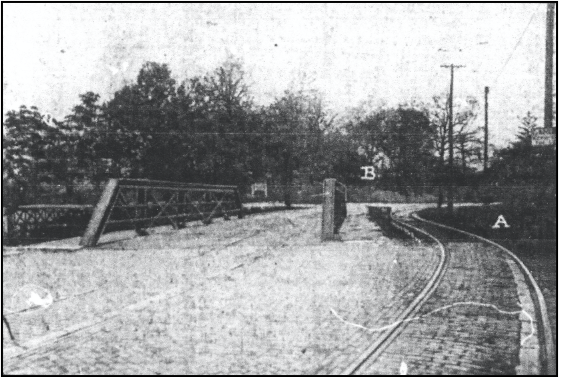
The photograph shows a view of this bridge across the old feeder canal (A), looking directly into Brook View the new Wildwood development (B). This familiar iron bridge which supplanted the old wooden structure of canal days has been classed as “dangerous,” because of the ease with which drivers may run their machines into the abandoned canal bed, and so it is soon to be torn out and the canal bed filled with paving material. This will give a more pleasing entrance to Brook View and remove possible cause for accidents at this sharp curve at the junction of Spy Run avenue and Clinton street.
The feeder canal mentioned in the caption is the St. Joseph feeder canal that carried water from the St. Joseph River located about 6½ miles north of Ft. Wayne to the summit of the Wabash & Erie Canal. The water fed into the W&E at its summit ran both east toward Toledo and west toward Lafayette.
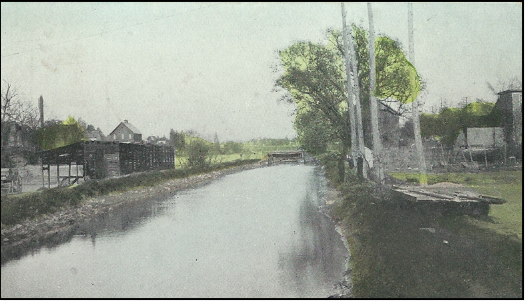 This photo is from an old post card that has the caption Mill Race and Dam, Huntington, Indiana. Lock gates can be seen in the dam, which backed up water that entered the Mill seen on the right behind the tree. You can see the mill race off to the right of the Wabash & Erie Canal just before the mill.
This photo is from an old post card that has the caption Mill Race and Dam, Huntington, Indiana. Lock gates can be seen in the dam, which backed up water that entered the Mill seen on the right behind the tree. You can see the mill race off to the right of the Wabash & Erie Canal just before the mill.
Canal Word Puzzles
CSI members have received puzzles by E-mail during the Coronavirus quarantine. These have been scrambled canal words, canal word searches and canal quotes. The following members have been the quickest to send in their correct answers to CSI Headquarters:
Scrambled Canal Terminology
Bob & Linda Barth—Somerville, New Jersey
Word Search 1
- James Crouse— Ft. Wayne, IN
- Jo Ann Ligget—Terre Haute, IN
- Cynthia Powers—Ft. Wayne, IN
Canal Quotes 1
- Paul McAfee — Ft. Wayne, IN
- Jo Ann Ligget—Terre Haute, IN
- Ed Powers—Ft. Wayne, IN
CSI Board of Directors Election
The Canal Society of Indiana normally elects its board of directors at its spring meeting/tour each year. This year its spring tour had to be canceled due to the Coronavirus quarantine. Therefore, we could not hold the election.
We have an 18 member board. Board members serve for three year periods with one third of them being elected or re-elected every three years. Up for re-election this year (2020) to serve until 2023 are the following:
Terry Bodine – Covington, Indiana
John Hillman – West Harrison, Indiana
Phyllis Mattheis – Cambridge City, Indiana
Cynthia Powers – Roanoke, Indiana (current CSI treasurer)
Sue Simerman – Ossian, Indiana (current CSI secretary)
Brian Stirm – Delphi, Indiana
Due to other commitments, Brian Stirm asked to be removed from the board. He will be placed on CSI’s Advisory Council. We thank him for all his past service.
Sue Simerman, nominating chairman, placed in nomination Preston Richardt from Elberfeld, Indiana to replace Brian. Preston’s biography follows this letter.
Once these positions are filled/refilled, the board elects officers for the society. Re-elected were: Bob Schmidt – president; Mike Morthorst – vice-president; Sue Simerman – secretary; Cynthia Powers – treasurer
This year’s election was conducted like the American Canal Society does. Each member was E-mailed a ballot. A favorable vote for all of the candidates was assumed unless a member responded with a contrary vote. They also could nominate someone for future Board membership as well. This eliminates lots of paper, envelopes and stamps or E-mails.
Preston B. Richardt: Amateur Historian
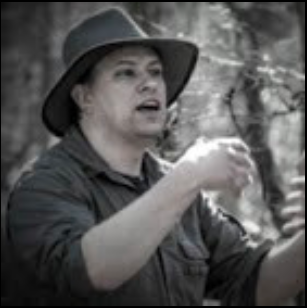
For 19 years my wife Chasity and I have called Gibson County home. We have four beautiful children three girls and a son: Abigail (student at Indiana State University), Elizabeth (Junior at Tecumseh High School, Lynnville IN), Gabriella (Freshman at Tecumseh High School, Lynnville IN) and Isaiah (5th grader at Barton Township Elementary School). We enjoy traveling, camping and many outdoor activities; family is important to me and I attempt to be involved with my family as much as I can, this has led me to be an assistant coach and basic archery instructor for two schools.
Since I was 14 years old I trained to become a firefighter and currently am a certified firefighter, emergency medical technician and technical rescue technician through the State of Indiana. I have been a career firefighter for a large private company in Warrick County where I have been for the last 14 years. Because of my current position I was introduced to Canal Society of Indiana (CSI) board member Dave Kurvach and found many common interests including, but not limited to, the canals of Indiana. I studied architectural design in college and worked as a draftsman briefly at the age of 19 for a small architectural firm in Evansville.
I am active in the community. I have served in many different roles through the years.
I have been involved with emergency services for many years, particularly the fire service, and have been a member of two volunteer fire departments. I even served as fire chief at one of them for two years before leaving to assist in another way in 2010.
I was elected by the citizens of Barton Township to serve as a board member on the Barton Township Advisory Board, which caused me to leave the volunteer fire department, and have held this position since 2011 serving in several different capacities including board President for several years. I am currently still doing my civic duty for my friends and neighbors.
Circa 2012, by a chance encounter while hiking along a trail in the Patoka River National Wildlife Refuge (Refuge), I met an individual who was on the board of directors for the friends group for the Refuge. Later that year, I received a call inquiring if I would be interested in serving as a board director for that same group which I agreed to. In this role I was placed in charge of trail maintenance on the refuge and led programs that focused on and around the Wabash and Erie Canal, which passed through Refuge property including the site of aqueduct 17 (Patoka River); to this day the canal programs have had the largest turnout of all programs at the Refuge. After my term limit was reached the Refuge Manager put my name in as a candidate for a new county board.
After four years of Refuge service, I was nominated and became a founding member of the Gibson County Parks and Recreation Department and was elected its first President. I served two years and then stepped down for personal reasons. During my tenure with the parks department, I was instrumental in the layout and the development of the county’s first county park; Hopkins Family Park in Francisco. I assisted with obtaining outside source funding from both public and private entities. Additionally, I made connections with other local leaders and persons of influence within Gibson County that would become instrumental in my fight to preserve the canal in the county. After my time with the Parks Department, I was asked to return to the Friends of Patoka River National Wildlife Refuge board of directors on which I currently serve.
In addition to my time with the above mentioned entities I have also provided educational experiences for the local elementary school and public libraries on the American Civil War and the Wabash and Erie Canal through Gibson County.
Canal Work:
In the autumn of 2000, I was taking an interest in some local history and, being from Elberfeld, Indiana, I had heard of the canal and even knew where it was basically around the area but I wanted more. This led me to begin researching it. At that time and location there was not a lot of information about the canal that I could find. I learned such things as where the towns of Dongola (Gibson Co.) and Millersburg (Warrick Co.) were and a few other things, but that was where my studies pretty much stopped. Around 2006/2007 I met CSI board member David Kurvach and we began discussing historical things. One topic that came up was the Wabash and Erie Canal; thanks to him, I found a renewed interest in the canal.
We began collecting and exchanging canal information; he focused on Warrick County and I began focusing on Gibson County. We would get together and lay paper maps and paper documents out. I tried to get it all collected electronically to prevent its loss. This led to me learn different ways of storing and presenting information about the canal. We also started going to different locations to photograph and document our findings; I even began videoing some locations to be able to present later via multimedia outlets such as YouTube and Facebook to gain more interest in the canal.
I began making maps through different media platforms eventually learning features in both Google Earth and Maps, which provided the abilities of what I wanted to do; share the maps and structures to the public.
In addition to learning how to map and display information in Google, I took a fond interest in the Patoka River Aqueduct (#17) and its design and construction. Based on engineers’ reports I applied the civil engineering terms I had learned to my understanding of aqueduct design. With my history as a draftsman, I also applied what I learned about Civil Engineering and made a 3D drawing of the aqueduct in AutoCAD (computer aided design). This was still not enough for me. In the fall of 2019 I built a scale model of the aqueduct and presented it in a public display at the Refuge Appreciation Day in October.
I believe the more interest one can make about a certain topic the more the public will feel the need to protect it. This belief paid off in the summer of 2017 when I learned a local county official wanted to remove box culvert 203 (at the time believed to be the last working wooden box culvert) and replace it with a more modern one. I began seeking help in protecting it from destruction from my many contacts at the Refuge, Canal Society, State Historical Society and Indiana DNR. Because the culvert sat just outside Refuge land, the Department of Interior was unable to assist directly, but it did provide me guidance to follow. It was ultimately my persistence and the Indiana DNR that put a stop to the culvert’s removal. A compromise was made to preserve the culvert while placing a new modern culvert higher than the original, which would act as an emergency runoff. Box Culvert 203 is now listed on the State of Indiana’s protected structure list; other structures have been identified and listed on that same list because of the contacts made during the Culvert 203 conflict. The following Spring (2018) the Gibson County Highway Department installed signage that the Canal Society of Indiana provided along areas of the Canal in Gibson County. Since that time I have become a local resource on the canal for Gibson County and private citizens.
I currently have moved my efforts north to Pike County, Daviess and Greene counties. In the fall of 2019 another wooden box culvert was located and found to be partially intact; that same day I visited the remnants of Lock 59 and the Newberry Dam. Because of modern technology and resources, I am working to build an interactive map that will be accessible for the public through the CSI website and, as things are discovered or updates needed, that will be able to be accomplished with relative ease.
I have a dream for the Wabash and Erie Canal. I hope the canal path will be protected and become a linear park with either state and/or federal protections for all to enjoy and learn.

